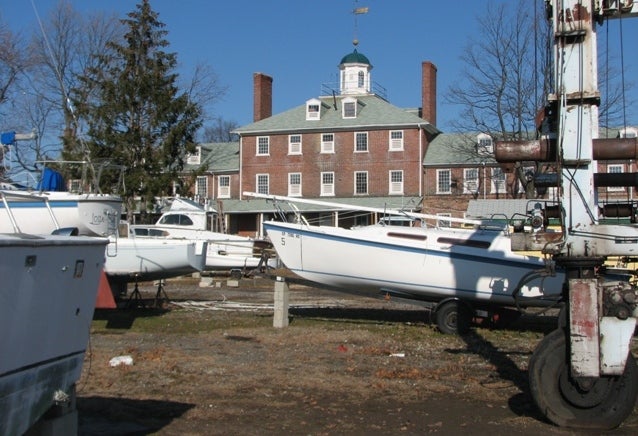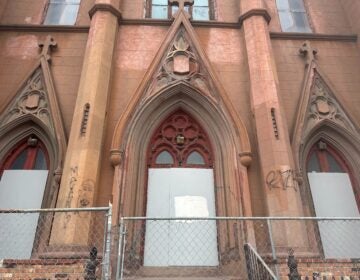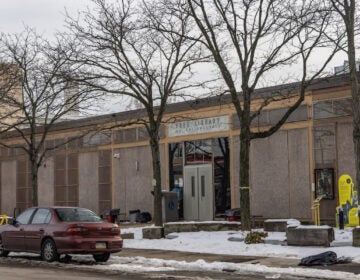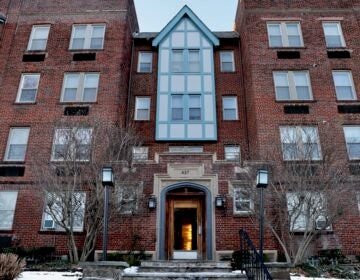Preservation Row: Lazaretto

Jan. 2
New series casts light on historic and unique sites that may be at risk of deterioration or demolition.
By Alan Jaffe
For PlanPhilly
Nearly a century before the immigration station at Ellis Island was built, Philadelphia screened new arrivals at the Lazaretto – a name that refers to the biblically resurrected Lazarus and, since the 15th century, the term for a quarantine station. The 10-acre complex along the Delaware River in Tinicum Township was erected in 1799 to fight waves of yellow fever that decimated the population of the city.
The 200-year-old Georgian structures of brick and wood still stand before ships traveling up the Delaware, the oldest surviving quarantine station in North America. But temporary planks help deteriorating wood columns prop up the sinking porch on the river side of the grand, three-and-a-half-story main building. Abandoned pleasure boats litter the site between the buildings and the water. And a large fire station, catering hall and parking lot block views of the site from the streets of the Essington section of Tinicum.
The site has been owned since 2005 by the township, which reached a settlement with the preservation community during a court battle over construction of the adjacent fire station. As part of the agreement, the Lazaretto Preservation Association of Tinicum Township, a board comprised of three representatives of the township and three from historic preservation organizations, was formed in 2007 and incorporated last June to manage five acres of the site and determine its future.
The preservation association is working on the creation of its bylaws, getting the organization “fully established,” and overseeing completion of a feasibility study for the Lazaretto, explained Paul Steinke, the representative of Preservation Pennsylvania on the board.
The feasibility study, conducted by the international design firm Stantec, explored several alternatives for the main building: residential use, academic use, such as a charter school, or office space. “The most feasible use is commercial office space,” Steinke said. The building “lays out well for that purpose, and that’s what it will probably end up being.”
The ultimate plan will include an interpretive component that explains the story of the Lazaretto, said Steinke, who is general manager of the Reading Terminal Market. “But we determined it is not feasible to use the entire building for that use. There are too many struggling museums” in the region, he said, and “the lessons are clear to everyone. It needs to have some income-producing component to keep it going.”
Larry Tice, a Philadelphia historian and the Wilbur and Orville Wright Distinguished Professor of History at East Carolina University, doesn’t agree with the study findings.
“I don’t think office is the best use. It should be a very active use site; it should be available for public activities” and include a large museum component, said Tice.
“I think to consign it to use as an office is to reduce it down to obscurity. We’ve seen too many places converted into office uses, and too frequently that is the end of its public recognition.”
The deep history of the site began long before the Lazaretto was constructed. Native Americans, including the Lenni Lenape, inhabited the beautiful waterfront land more than a century before the arrival of Swedish, Dutch and English settlers to the area in the mid-1600s.
In 1793, the yellow fever epidemic struck the region and killed about 5,000. The Philadelphia Board of Health was formed in 1798, and it erected the Lazaretto over the next two years in the Georgian design that characterized many of Philadelphia’s prominent public buildings when it was the nation’s capitol. The Lazaretto served as the point of entry for all the ships and passengers arriving in the Port of Philadelphia, including thousands of German, Irish and Scandinavian immigrants, until 1893. The ships were detained for 30 days, until the station staff was convinced there was no disease onboard.
In 1800, the Lazaretto also served as a safe haven for Africans found aboard two illegal slave ships captured off the coast of Cuba. The African men, women and children were nursed back to health by the Lazaretto staff, and the Abolition Society of Philadelphia took over their guardianship, according to research by historian Dona Horowitz-Behrend.
From the late 1890s to 1930s, the Lazaretto was used as an athletic club and then as a flying school and seaplane base. Part of the property was leased to the Riverside Yacht Club beginning in 1937. In 1972, it was placed on the National Register of Historic Places.
Tinicum Township purchased the entire site in 2005 and began construction of the $7 million firehouse on five acres of the property. The Preservation Alliance of Philadelphia filed suit to stop the project, which it said threatened the integrity of the historic landmark. The settlement reached in November 2006 allowed the completion of the firehouse complex and the formation of the preservation board to watch over the rest of the property.
Tice, a former director of the Pennsylvania Historical and Museum Commission and past State Historic Preservation Officer, worked with other historians several years ago on an “open letter” to officials and the public concerning the fate of the Lazaretto. The options they considered were mothballing the principal buildings until a proper use could be agreed upon; mixed use for a public facility and protected historic buildings; a center for education and research in immigration and public health; and the creation of a national historic site with a museum and visitor facility. Citing the “unique importance” of the site, the group recommended the last option as the best use of the Lazaretto.
The open letter also pointed out that “the very survival of the Lazaretto to the present in its almost pristine form is one of the minor miracles of serendipity, good sense, and chance for over 200 years.”
The township has repaired the main building in recent years, Steinke noted. It has fixed leaks, paid for heating of the interior, and replaced broken windows. “It’s pretty well buttoned up and sealed” while it awaits a decision on the re-use plan, he said.
Tice, who makes regular visits to the site, concurred that the building remains in “sound condition.” But he has also observed the accumulation of debris on the porch, “which is slowly sinking and with it the roof over the porch.” A chain link fence that once ran along the perimeter of the site is mostly gone, leaving it open to vandalism, and there is no appearance of regular property management or maintenance, Tice said. “In general, I would say that the building is unprotected, and the entire site appears to be abandoned.”
To Tice and other historians, the Lazaretto is the best preserved and most important and accessible location for telling the story of immigration, security and public health issues during the nation’s first century. It could also be “the greatest economic, cultural and focal asset of the township and surrounding area,” he said.
Contact the reporter at alanjaffe@mac.com
Previous stories:
WHYY is your source for fact-based, in-depth journalism and information. As a nonprofit organization, we rely on financial support from readers like you. Please give today.






